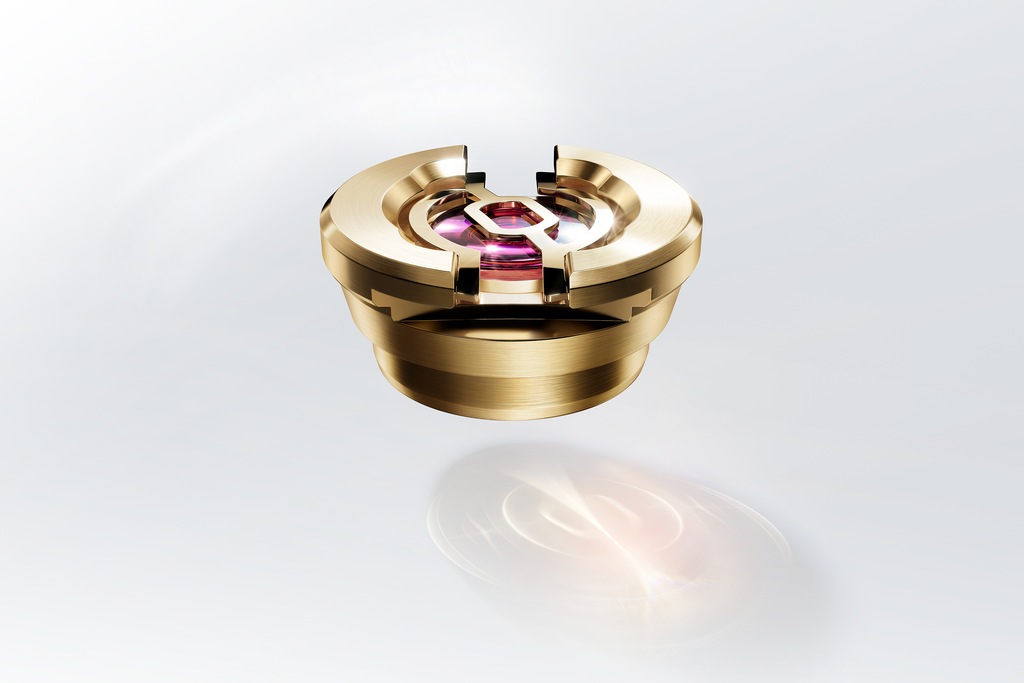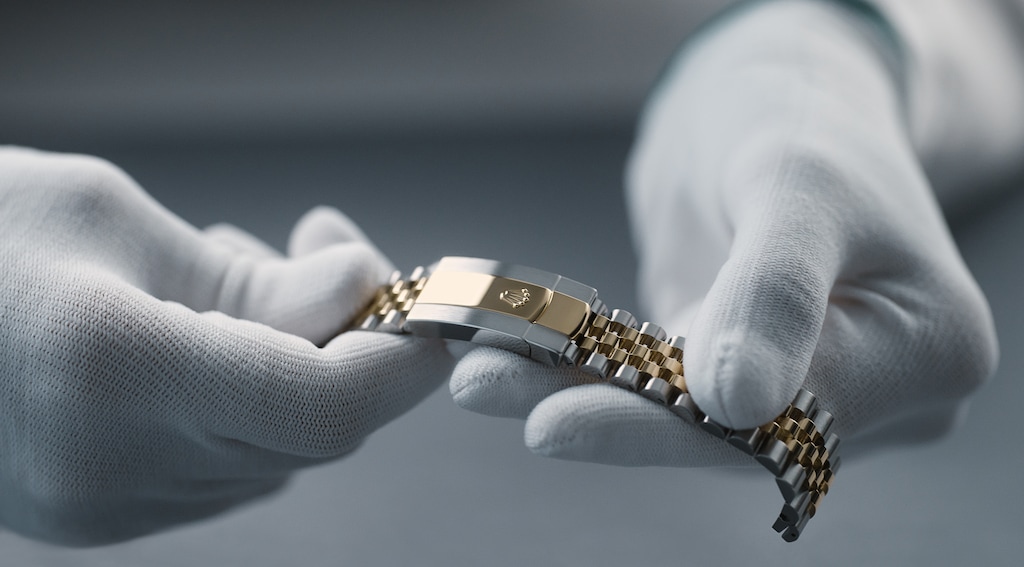Since Rolex was founded by Hans Wilsdorf in 1905, for more than a century, Rolex watches have been renowned for their high precision and accuracy — a function of the exquisite movements designed and precisely constructed in-house by the Swiss watch manufacture.
A true innovator, Rolex is responsible for some of the most important watchmaking developments in modern horological history.
In 1931, for instance, Rolex invented and patented a self-winding mechanism with a free rotor, called the Perpetual rotor. The Perpetual rotor consists of a half-moon-shaped oscillating weight rotating freely on its axle in both directions under the impetus of the wearer’s wrist movements. The rotor transmits energy to the mainspring, the motor of the watch.
To ensure excellent precision, in 2000 Rolex introduced a patented hairspring in an exclusive alloy of niobium, zirconium and oxygen: the Parachrom hairspring. (For those unfamiliar with the device, a hairspring is a fine coil that controls the oscillation of a mechanical watch’s balance wheel, regulating the release of energy from the watch’s mainspring and thereby, ensuring precision timekeeping.) Entirely manufactured in-house by the Swiss watch manufacture, this strategic component, half a centimetre in diameter, offers major advantages for precision timekeeping: it is insensitive to magnetic fields, offers great stability in the face of temperature variations and remains up to 10 times more accurate than a traditional hairspring in case of shocks.
In 2005, Rolex introduced a new patented process to modify the surface of the Parachrom hairspring and thereby further reinforce its long term stability. This same treatment produces its characteristic blue colour.

In order to increase the resistance of its movements to shocks – particularly if dropped – Rolex developed and patented an exclusive and highly efficient shock absorber: Paraflex (above). These miniscule, shock-absorbers protect delicate components of the movement from damage, dispersing the energy of impacts and ensuring Rolex watches stand up to the rigours of sports such as sailing, mountain climbing and tennis — activities with which the brand has long been associated with.
More recently in 2015, Rolex engineers devised and patented a new escapement that optimizes the efficiency of the Swiss lever escapement, the standard in Swiss watchmaking, but which had seen only limited technical evolution in the last 50 years. The result of extensive research, the geometry of the new Rolex Chronergy (above) escapement improves the efficiency of this key component by 15 per cent. It accounts for almost half of the increased autonomy of the new 3235 and 3255 movements. Made of nickel-phosphorus, the Chronergy escapement is, furthermore, resistant to magnetic interference.
Hermetically sealing the movement and protecting it from environmental contaminants, the Rolex Oyster case — descendant of the world’s very first waterproof watch launched by Rolex in 1926 — is a paragon of engineering, excellence and timeless style. Crafted in precious metal alloys artfully smelted at Rolex’s proprietary foundry in Geneva, hewn from Oystersteel, 18 ct gold, 950 platinum or RLX titanium, Rolex cases are fiercely fortified against erosion — and as the Oyster moniker suggests, remarkably waterproof.
The embodiment of Rolex’s commitment to superior waterproofing, the Ringlock system (above) that was introduced in 2008 builds on the legacy of the original Oyster case, enhancing the depth capabilities of Rolex diving watches. This patented case architecture, consisting of three layers: a thick, slightly domed sapphire crystal with an anti-reflective coating, a high-performance nitrogen-alloyed steel ring and a case back made from RLX titanium — is designed and built to withstand the colossal pressure exerted by water at the depth of 3,900 metres.
Further protecting Rolex deep-sea dive watches such as the Oyster Perpetual Sea-Dweller and Oyster Perpetual Rolex Deepsea from the threats encountered during scuba diving is a helium escape valve. Developed by Rolex in 1967, this patented innovation ensures excess pressure built up inside the watch case is safely released during a diver’s decompression phase in a hyperbaric chamber.
Then there’s the legendary Triplock winding crown — carrying the regal Rolex logo, and possessing screw-down properties to provide additional resilience against environmental interference.
The bezels of Rolex watches are another distinctive touchpoint. Whether it’s the dazzling fluted bezel that dates back to the brand’s earliest history (today, exclusively crafted in 18 ct gold or 950 platinum), or one of Rolex’s hardy, hyper-modern, scratch- and discoloration-proof Cerachrom inserts (as seen on the Oyster Perpetual Cosmograph Daytona and Oyster Perpetual GMT-Master II), through to the innovative Ring Command system (below) found on the Oyster Perpetual Sky-Dweller, each Rolex bezel faithfully serves its purpose — whether the function be to aid split-second timing, or simply enhance the beauty of the timepiece.
An outstanding watch is only as good as the bracelet that affixes it to the wrist. That’s why the Swiss watch manufacture pays just as much attention to the quality of its bracelets as any other component of its watches.
The iconic Oyster bracelet, which was developed in the late 1930s, embodies the craftsmanship and form-follows-function aesthetic for which the brand is justly famed. Equally as distinctive is the Jubilee bracelet (below)— an elegant five-piece link bracelet specially designed for the Oyster Perpetual Datejust and introduced in 1945 to mark Rolex’s 40th anniversary.

Not one to rest on its laurels, in keeping with its perpetual pursuit of improvement, Rolex constantly seeks to better the design and functionality of its bracelets. For example, the Easylink system, patented in 1996, provides a quick 5 mm bracelet adjustment under the clasp, ensuring perfect fit and comfort as the wrist expands and shrinks. In 2008, Rolex launched the Glidelock extension system (below), allowing for precise adjustments of bracelet length without tools. It is discreetly integrated into dive watch clasps, offering swift adaptability to changing conditions.
The Fliplock extension system, designed for the Oyster Perpetual Deepsea Challenge, extends the bracelet by approximately 26 mm, accommodating wetsuits up to 7 mm thick. The Oysterflex bracelet, introduced in 2015, features two supple metal blades, overmoulded with a high-performance elastomer for incomparable durability and comfort. It exemplifies Rolex’s commitment to excellence in both watchmaking and bracelet design, ensuring that their watches and bracelets stand the test of time — and remain firmly planted on the owner’s wrist.
Throughout its history, Rolex has perpetually pushed the boundaries of horological innovation, producing beautiful watches of impeccable precision, reliability, craftsmanship and functionality. It is these qualities that, at its core, comprise the anatomy of a Rolex watch, lending resonance to the guarantee of quality that is the green Rolex seal, and giving ultimate meaning to the Rolex name.


















